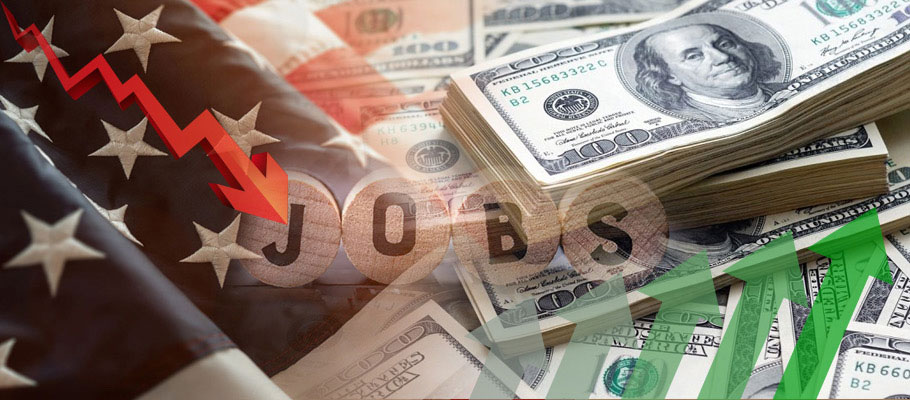
Published: September 6th, 2023
Forex traders have been unfazed by an underwhelming set of US labour market figures. US employment growth in June and July of 2023 was much weaker than consensus had expected, though August’s non-farm payrolls figure was slightly ahead of forecast.
Wage growth also slowed, supporting investor expectations that the Federal Reserve will not raise interest rates in September.
The implied likelihood of a September rate increase has dropped to around seven per cent in the 48 hours following release of the employment data. At the end of last week, the probability of an increase was seen to be around 20 per cent.
The immediate reaction from traders was straightforward, with USD and yields taking an initial hit, but the downtrend didn’t last.
Once markets absorbed the news and its implications, long-dated US Treasury yields surged upward again, which was supportive of the Greenback.
Forex analysts at Barclay’s said in a market note that rising oil prices and a stronger ISM manufacturing survey may have been behind the quick reversal.
Looking ahead, they said, the outlook for USD was increasingly favourable. ‘The US economy is already looking more resilient than the Eurozone’s. The recent spike in energy prices could wident he gap further, impacting the Euro-Dollar rate in terms of trade flows and growth differentials.’
In Asia, a series of stimulus measures by Beijing seem to have restored confidence among Chinese investors.
Last week, China increased support for households with tax breaks for child care and education spending.
At mid-year, Analysts at London-based Capital Economics saw a positive trajectory for the Greenback across much of 2H 2023, with key events on the horizon including policy meetings by the European Central Bank (ECB) and the Bank of Japan (BoJ). Both are expected to influence thinking at the US Federal Reserve.
In a market commentary, the firm said the ECB was expected to hike interest rates that month, and many analysts expected at least one more 2023 rate rise. Frankfurt’s decision came on the back of a US inflation data print that helped determine whether the US Federal Reserve will pause or set the stage for another rate hike down the road.
‘Consensus sees the Fed keeping rate hikes on hold and most analysts expect the Bank of Japan to hold the line as well; however, a few holdouts are looking for the BoJ to make an adjustment to yield curve control on Thursday.’
Noting the complexities around the Fed’s decision, Capital Economics said mid-year data supported arguments for both a pause on interest rate hikes, and a rise.
When the wider market outlook was considered, it underscored the impact of G10 monetary policy and inflation on the Greenback’s performance for the year-to-date. "For Dollar bulls, Fed decisions weigh(ed) heavily on trading decisions. However, US growth is stubbornly strong, and inflation has been sticky. Traders have to look at the Fed's base case, which is higher for longer. That’s a positive for USD.’
The US Dollar Index (DXY) retraced in the month prior to the report. After an ascent towards 105, it fell back slightly around the 100-day moving average to touch 103.38. Capital Economics believed that unless a dovish pause happens, USD would regain strength throughout July and August, possibly surpassing the 105 level.
In February 2023, analysts at global investment bank Mitsubishi UFJ Financial Group (MUFG) pegged the Dollar to push back against a resurgent Euro. EUR, they said, would remain on the back foot as USD staged a comeback from late January.
Forex traders, they said, were shrugging off the imminent release of minutes by the US Fed’s open markets committee and downplaying the impact of recent PCE deflator data. MUFG said all signs pointed to a period of Dollar dominance.
‘The upward adjustment to a higher terminal rate and cooling rate cut expectations for later in 2023 have spurred new life into the strong USD trade we saw at the end of 2022,’ says MUFG’s briefing.
Adding wind to USD’s sails is a lifting of investor expectations about the timing of the Federal Reserve's peak interest rate hiking cycle.
A month before in January, consensus predicted that the last rate rise would come in March, but an additional two hikes were later added to the timetable. The likelihood of a rate cut in the latter part of 2023 had receded, it was believed, giving the Dollar support after an underwhelming end to 2022.
EURUSD rushed toward 1.10 in January but had fallen back by early February as new US economic data flummoxed analysts, who sent mixed signals into the market.
A surprising mix of strong wage data, labour market dynamics, inflation figures and retail sales suggested the American economy was robust enough to achieve the Fed’s above-target inflation levels. EURUSD started to retrace previous gains as a result.
‘Stronger American growth data blended with firmer inflation at the beginning of 2023 has added optimism to markets. Forex traders are now pricing-in a more hawkish outlook for Fed policy’.
Last March, high oil prices were pushing the Euro toward multi-year lows as forex traders bet that the European Central Bank would delay plans to raise interest rates later in the year.
Benchmark crude oil prices also reached USD 130 per barrel, the highest level in nearly 12 years. Wholesale gas prices more than doubled from the previous month against worries that Washington would try for a total ban on oil from Russia.
The White House did move forward with plans to ban purchases of Russian oil and gas, with other G7 countries following suit. European natural gas prices responded by hitting an all-time high.
Analysts at Crédit Agricole’s FX strategy unit wrote that there were reports of major Western importers weighing coordinated sanctions against Russian oil and gas. The news sent energy and commodity prices soaring.